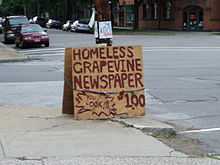Homeless Grapevine

The Homeless Grapevine is a street newspaper sold by homeless in Cleveland, Ohio, U.S.A. It is published by the Northeast Ohio Coalition for the Homeless (NEOCH). Vendors buy the paper for 25 cents per copy and sell them for 1 dollar. The papers attempts to be a voice for the homeless and content is entirely dedicated to homeless issues, much of it is written by current or former homeless.[1] It is a monthly magazine of 16 pages and as of 2004 it has a circulation of 5000 copies sold by 15-20 vendors.[2][3] Sellers are often at The West Side Market, Public Square, E. 9th St., East 12th and Coventry.[1]
History

It was started in 1991 by Kent State University student Fred Maier and was originally photocopied and sold for 25 cents. In 1993 it was taken over NEOCH and its former director Bryan Gillooly, who published the first issue of the new Homeless Grapevine that spring.[2][3][4]
The special issue 65(a) in May-June 2004 was entirely dedicated to Daniel Thompson, the poet laureate of Cuyahoga County, who was also a homeless advocate and had often written for the paper.[3]
The Homeless Grapevine was listed as a "notable entry" in the 2006 Knight-Batten Awards with the comment "A pat on the back for job well done".[5] The paper won the Greater Cleveland Community Shares Social Justice Reporting Award in 2005.[6]
Legal activities
In the mid-1990s, the city required that Grapevine sellers have a peddlers' license, costing 50 dollars. After one vendor was ticketed, the American Civil Liberties Union of Ohio argued that it was a violation of the First Amendment and the charges were dropped. A lawsuit[7] was also filed on behalf of homeless vendors and the Nation of Islam that was selling their newspaper The Final Call in public. A district court ruled with the vendors, but the Sixth Circuit Appeals Court reversed it, siding with the city.[2][8][9][10]
According to ACLU representatives, the Grapevine's coverage also played a major role in resolving another ACLU lawsuit,[11] which had been brought against the city for transporting homeless to isolated areas.[12]
References
- ↑ 1.0 1.1 "The Homeless Grapevine". NEOCH website. Retrieved 2009-03-21.
- ↑ 2.0 2.1 2.2 Heinz, Teresa L.; Levinson, David (2004). Encyclopedia of Homelessness (illustrated ed.). SAGE. pp. 538–9. ISBN 0-7619-2751-4. Retrieved 2009-03-21.
- ↑ 3.0 3.1 3.2 Gill, Michael (2004-04-28). "City Chatter : The Poet And The Homeless". Cleveland Free Times. Volume 12, Issue 1. Retrieved 2009-03-21.
- ↑ Taddie, Jean (August-September 1996). "The Grapevine Empowers Cleveland's Homeless". The Homeless Grapevine #17 (NEOCH). Retrieved 2009-03-21.
- ↑ "2006 Notable Entries". Knight-Batten Award. American University School of Communication. Retrieved 2009-03-21.
- ↑ Northeast Ohio Coalition for the Homeless v. City of Cleveland, filed September 27, 1994 (N.D. Ohio).
- ↑ Herz, Rick; Hagler, Tamar (1994). No Homeless People Allowed: A Report on Anti-homeless Laws, Litigation and Alternatives in 49 United States Cities. DIANE Publishing / National Law Center on Homelessness and Poverty. p. 77. ISBN 0-7881-1549-9. Retrieved 2009-03-21.
- ↑ Cunningham, Kelly (1999). Out of Sight--Out of Mind?: A Report on Anti-Homeless Laws, Litigation and Alternatives in 50 U. S. Cities. DIANE Publishing / National Law Center on Homelessness and Poverty. p. 79. ISBN 0-7881-8276-5. Retrieved 2009-03-21.
- ↑ Sufrin, Claire. "StreetWise Among Best Sellers of Its Kind". The Chicago Reporter. Retrieved 2009-03-21.
- ↑ Clements v. City of Cleveland, filed October 4, 1994 (N.D. Ohio).
- ↑ Van Lier, Piet (1999-08-06). "Read All About It! -- Street Papers Have the Real Story". Jinn Magazine Issue No. 5.15. Pacific News Service. Retrieved 2009-03-21.
External links
| |||||||||||||||||||||||||||||||||||||||||||||||||||||||